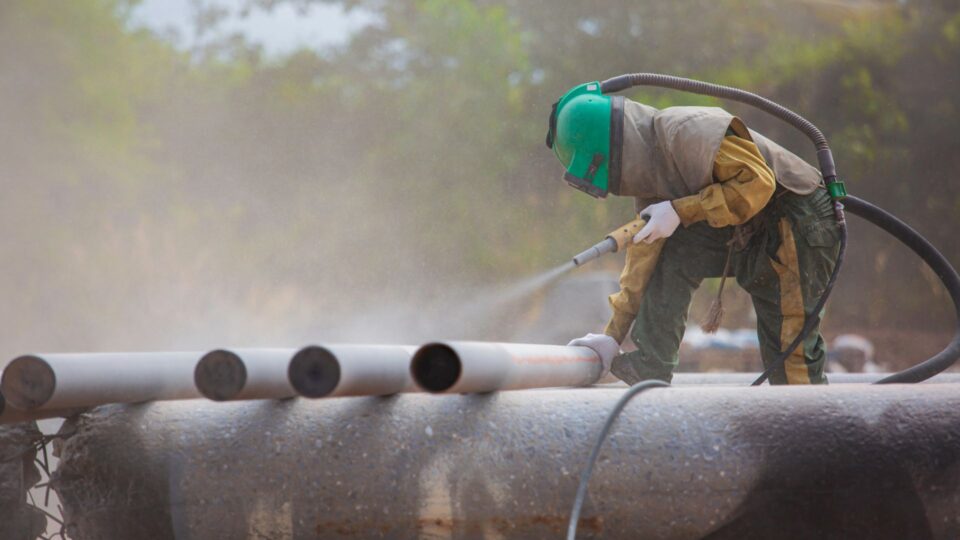Occupational lung disease contributed to over 6799 deaths in Australia between 2011 and 2020. Managing occupational lung hazards is essential in building and construction industries – mainly when grit blasting takes place.
What are the consequences of lung hazards in the workplace, and what can you do to prevent occupational lung disease?
Read on as we explore why grit blasting presents a risk, and what you can do to reduce its impact.
What is the difference between grit blasting and abrasive blasting?
Here are some of the core differences between grit blasting and abrasive blasting:
- Grit blasting propels abrasive grit particles at high speed to clean or prime a surface.
- Abrasive blasting is a general term describing various methods to achieve similar results.
- Grit blasting uses aluminium oxide, garnet, or steel shot grit particles, whereas abrasive blasting uses finer particles like sand, glass beads, or synthetic materials.
- Grit blasting is better suited to provide significant surface preparation, whereas abrasive blasting provides cleaning, deburring, etching, and surface finishing for less intensive purposes.
- Pressure blast cabinets and portable blasting machines are required for grit blasting.
- On the other hand, Abrasive blasting uses suction blasting, wet blasting, and blast rooms.
Overall, grit blasting provides more priming for heavy-duty applications, and abrasive blasting describes a broader range of surface priming methods.
Which industries use grit and abrasive blasting?
Let’s discuss the different industries that use grit and abrasive blasting and what they are used for in each industry sector.
● Shipbuilding and hull cleaning – grit blasting removes marine growth, old coatings, and rust from ships. It also provides priming for new paint coatings.
● Automotive repair and restoration – grit blasting helps strip paint, rust, and corrosion from car components, allowing a clean surface for welding and refinishing.
● Construction and contracting – grit blasting allows concrete cleaning, surface contaminant removal, and surface finishing in the construction industry.
● Metal finishing – grit blasting helps to remove burrs, oxides, and scale from metal for finishing.
● Welding – grit blasting helps welding by preparing surfaces to facilitate fusion and strong joints.
● Metal casting and foundry work – grit blasting provides cleaning and preparation for casting moulds in metal casting processes.
● Surface or powder coating – grit blasting helps prepare a substrate surface and remove old coatings and contaminants.
● Painting – grit blasting helps remove old paint and prime a surface to ensure proper paint adhesion.
Why is grit blasting considered hazardous?
Grit blasting is considered an airborne hazard for the following reasons:
- Respirable particles – the fine airborne particles created during blasting are small enough to be inhaled, leading to respiratory damage.
- Silica exposure – crystalline silica forms when materials like sand or quartz are used in blasting. Silica dust can lead to silicosis, a serious lung disease that can cause scarring and reduce lung function.
- Toxic substances – lead-based paint and other hazardous coatings can become airborne in the grit blasting process, leading to poisoning for workers.
How to mitigate the damage of grit blasting.
To provide more health and safety during grit blasting, you can invest in ventilation solutions called dust collectors.
Dust collectors help to capture and trap airborne particles. This makes them more effective at extracting grit particles from the air than other types of ventilation. They can remove toxic particles and fine dust from the air to prevent it from entering workers’ lungs.
You must adopt a dust collector for grit blasting to comply with industry regulations and ensure your workers are safe.
If you’re unsure which dust collection system is suited to your industrial environment, you can speak to a ventilation expert. They will be able to advise you on the ideal solution for your environment, along with the right ventilation capacity and the number of collectors you require.

Choose Fanquip for dust ventilation solutions.
Grit blasting is a valuable tool to prime surfaces ready for painting or to remove debris and corrosion from heavy-duty materials. However, the dust particles created by grit blasting can risk workers’ lung health. Implementing dust collectors will ensure industry compliance and help mitigate this risk to worker health.
Fanquip provides industry-compliant dust collectors to help you maintain workplace safety. Contact us today to learn more about our ventilation solutions.
